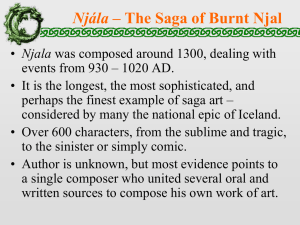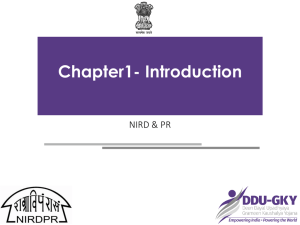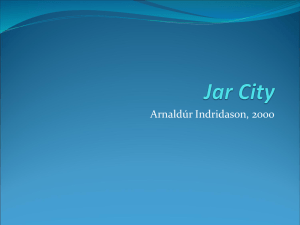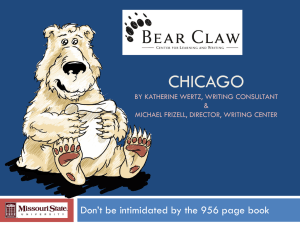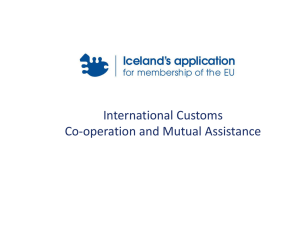Njal`s Saga 1
advertisement
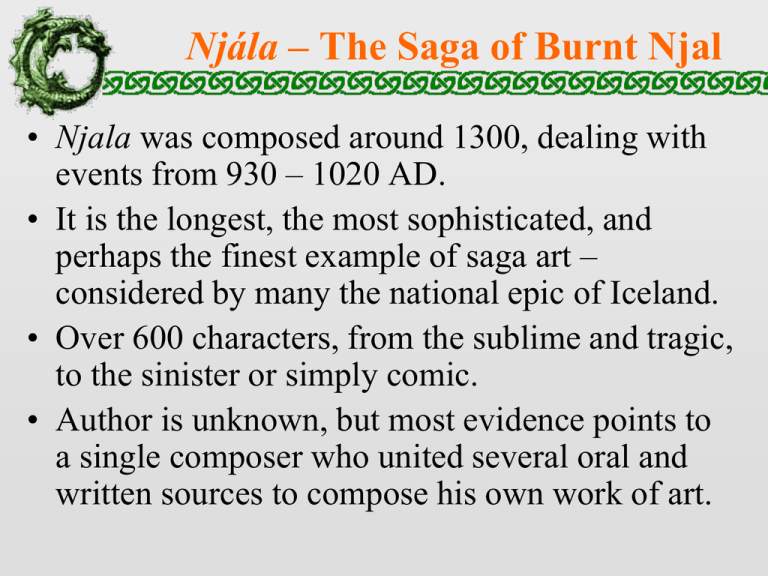
Njála – The Saga of Burnt Njal • Njala was composed around 1300, dealing with events from 930 – 1020 AD. • It is the longest, the most sophisticated, and perhaps the finest example of saga art – considered by many the national epic of Iceland. • Over 600 characters, from the sublime and tragic, to the sinister or simply comic. • Author is unknown, but most evidence points to a single composer who united several oral and written sources to compose his own work of art. Njála – Basic Information • Njála can be divided into roughly three sections: • Gunnar’s exploits and death • Njal’s family and his death • Kari’s vengeance and reconciliation • The saga juxtaposes a heroic, Viking age mentality with a modern, Christian ethos. Some of the themes in the saga include: Honor Law Luck Vengeance Fate or Destiny Nobility of Character Christian Charity Reconciliation Pride Njála – History • Critics are divided whether to treat Njála as a work of history or a work of literature. Obviously it contains elements of both, but generally one can say that the author uses historical events to explore aspects of human nature. • Some critics see Njála as a form of Historical Novel, as a work dealing indirectly with the concerns of the age in which it was created, the turbulent period when the Icelandic Republic collapsed (1262). Njála – History • How did the saga come to be composed? • 250-300 year gap between the events of the saga and its composition. Oral history. • Many events are taken from later written sources, such as the conversion of Iceland, the legal debates, the battle of Clontarf in Ireland. • The “Free Prose Theory” – oral stories simply written down according to rules of oral narration. • The “Book Prose Theory” – a writer/editor collects oral tales and rearranges/adapts them for a written text that mirrors rules of oral narration. Timeline of Icelandic History Njála – Style and Form • Njála has been called “the finest example of art without art,” and “the despair of translators,” a masterpiece of story telling, smooth and plain. • A narrator exists, but conceals himself behind the apparently objective portrayal of characters. • The narrator presents no interior descriptions, explains no motivation, and provides no commentary (except that of “everyone” or “most people”). • Characters are what they say and what they do– most scenes contain important bits of dialogue! Njála – Genre • Of the four great Icelandic family sagas (Egils saga, Eyrbyggja Saga, Laxdæla saga), Njála is the longest and most complicated. • Njála contains many different genres: • Saga of constitutional history and saga of law • Saga of the conversion of Iceland • Saga of family feud and violent lawlessness • Saga of heroic adventure • Saga of Christian reconciliation • Saga of pagan wisdom, fate and fatality Njála – Verisimilitude • Njála, like all Icelandic Family Sagas, purports to represent real local history. • People are given real names and real family ancestries, which link them to real places. • Njal’s farm at Bergthorsknoll still exists, evidence of a burning there from the proper time. • “Factual” evidence provides the saga with a certain legitimacy – proof for the reader – though it is impossible to determine how much is really true. • Sagas a form of “serious entertainment.” Njála – Foreshadowing • In Njála, as in most sagas, the authors are dealing with tales well-known to their audiences. • Suspense – what will happen next? – does not exist in a modern sense. • Elements of foreshadowing – dreams, omens, portents, etc. – remind the audience of what is to come, and they provide the saga with coherence, uniting earlier and later episodes. • The attention of the audience is focused on how and why things happen, not on twists of the plot. • Readers have to pay close attention! Njála – Plot Elements • According to scholar T.M. Anderson, there are 6 key elements to the narrative structure of family sagas: 1. Introduction 2. Conflict 3. Climax 4. Revenge (repeat as necessary) 5. Reconciliation 6. Aftermath Njála – 1. • The saga begins with Mord Gigja (Fiddle), a powerful chieftain (goði), who lived at Rangriver Plains (Rangarvellir), in southern Iceland. • Mord has a beautiful daughter called Unn (3). • At Breidafjord, near Laxardal in West Iceland, lives Hoskuld Dala-Kollsson, who has a halfbrother Hrut (3). • Hrut has a niece Hallgerd, who is a beautiful young girl at the time (3) – the long hair will show up again at an important juncture in the saga. The World of the Icelandic Sagas Map of Iceland Njála – 1-2. • Hrut makes an ominous comment about Hallgerd (4): “The child is quite beautiful, and many will pay for that; but what I don’t know is how the eyes of a thief have come into our family.” • Hoskuld and Hrut ride to the Althing, the national Assembly in Iceland, held at Thingvellir for two weeks in late June. • Hoskuld suggests that Hrut marry Unn, though he is unsure “whether we are meant to be happy together” (4). Njála – 2. • Hoskuld and Mord settle on terms of marriage to ensure that Unn will live well and that she will keep her wealth (5). • The call witnesses to seal the bargain, the wedding will take place that summer. • Hrut soon learns, however, that his brother Eyvind has died, and that he must go to Norway to claim his inheritance. • Hrut meets with Mord, and they agree to postpone the wedding for 3 years. Njála – 3. • Harald Grey-Cloak is King of Norway (961-970 AD), and rules with his mother, Queen Gunnhild – cf. Egil’s saga (6). • Gunnhild promises Hrut her aid in recovering his money, and Ozur tells him it would be wise to accept her “generosity” (7). • Hrut meets the king, asks to become a retainer; Gunnhild supports his request. • That evening, Queen Gunnhild makes Hrut a proposition he cannot refuse…(cite 9) • Hrut takes a place of honor; spends the winter. Njála – 4-5. • A man named Soti has stolen Hrut’s inheritance; Gunnhild and the king give Hrut ships and Ulf the Unwashed to aid his search. • Hrut sails into the pirate Atli Arnvidarson, and they fight a Viking sea battle (cite 11). • Hrut kills Atli, but Ulf the Unwashed dies. • Like all Icelanders in the story, Hrut finds great success in mercenary activities in Norway. • Soti is found, arrested and hanged. • Hrut collects his inheritance, gives Queen Gunnhild half. Njála – 6-7. • Hrut wants to leave Norway; he lies to Gunnhild about the reason (12). • She is upset and curses him for lying (cite 13). • Hrut returns to Iceland and marries Unn. • Their marriage remains unconsummated, and eventually Unn determines to divorce Hrut. • Unn visits her father at the Althing, tells him the reason for her marital unhappiness (cite 15f.). • Mord tells Unn the proper legal procedure for executing a divorce (cite 16). Women have more equality in Iceland than elsewhere at this time. Njála – 8. • At the Althing, Mord puts forward a claim for the return of his daughter Unn’s dowry (and Hrut’s contribution to the marriage agreement!). • Hrut refuses to pay and challenges Mord to a duel – Holmganga, or island-going – which in the early years of the Icelandic Republic was an accepted means of deciding legal disputes. • Old Mord is afraid to fight the tough Hrut, so he lets his claim fall, earning nothing but ridicule. • Hrut keeps the money of Unn’s dowry. • Who was right and who was wrong? The Legal Courts of the Althing in Republican Iceland Njála – 9-10. • Hallgerd grows up to be a beautiful, but willful and impetuous woman (cite 18). • Hallgerd has been raised by her foster-father, Thjostolf, an insanely jealous and violent man. • Fostering another’s child was a way to cement bonds between families; the subordinate man usually did the fostering; the father kept final authority over the child. • Hoskuld, Hallgerd’s father, decides to marry her to Thorvald, without informing her. • Hallgerd thinks the man beneath her, but agrees. Njála – 10-11. • Thjostolf comforts Hallgerd, saying that he will take care of her first marriage (20). • The wedding is large and happy, though Hrut senses that it will have no luck. • At the wedding, we are introduced to Svan, an evil magician related to Hallgerd. • Hallgerd is wasteful, but blames her new husband; in fury, he strikes her in the face (21). • Thjostolf finds Thorvald, insults him and then plants his axe in husband #1’s skull (cite 22). • The insult provided an excuse to begin the fight. Njála – 12. • When Hallgerd sees his bloody axe, Thjostolf tells her that he has arranged it so that she can get a better marriage. • Hallgerd sends him to hide with evil Svan in the hills; Svan is impressed by the murder (23). • Osvif gathers his friends and family to seek vengeance against Thjostolf. • Svan uses magic to send fetches (fylgja) and fog against the party, and they turn back (cite 24) • Osvif goes to Hoskuld and asks for compensation; Hrut advises him to pay up and sets price (25). Duty of Revenge and Right of Inheritance Njála – 13-15. • Glum Olafsson now wants to marry Hallgerd; his brother warns him, but he persists (27). • Hoskuld tells Glum about all her assets and defects, and they discuss the matter with Hallgerd, who is not averse to the marriage. • The marriage starts out well and happy, and a daughter Thorgerd is born (29). • Thjostolf wears out his welcome at Hoskuld’s house and goes to visit Hallgerd. • Hallgerd talks Glum into letting Thjostolf stay at their farm. Njála – 16-17. • Nasty Thjostolf refuses to work, and when Hallgerd defends him, Glum quarrels with her and slaps her (31). • She is upset, but loves Glum deeply and forbids Thjostolf from doing anything. • Thjostolf waits for a moment alone, then axes beloved Glum, husband #2 (cite 32). • When Hallgerd sees the bloody axe, she guesses the truth and laughs! • Hallgerd sends Thjostolf to Hrut… what are her intentions here? Njála – 17-18. • Hrut does not care for Thjostolf’s madness, and kills him straight away (33). • Brother Thorarin asks for compensation for Glum – his claim is weak because Hrut has already killed Thjostolf – but he is given compensation by Hoskuld and Hrut anyway (34). • These gifts – and a cloak – are a sign of great nobility and generosity of spirit. • Petite Unn, meanwhile, has squandered her wealth. Her father is dead and so she turns to assistance to another relative – Gunnar. Njála – 19-21. • Gunnar Hamundarson of Hlidarendi; a farmer and an ideal hero (cite 34f.). • Njal Thorgeirsson of Bergthorshvol, wealthy and wise, and extremely skilled at law, but could not grow a beard (cite 35f.). • Njal has a wife, Bergthora, who is courageous, but more than a little harsh-natured. • Impoverished Unn comes to Gunnar for aid – she wants his assistance to recover her dowry from Hrut (36). • Gunnar goes to his friend Njal for advice. Hlidarendi Bergthorshvoll Bergthorshvoll Njála – 22-24. • Njal gives Gunnar precise directions for a legal assault against Hrut – basically a trick to get Hrut to recite the summons to revive the case legally (37f.). • Gunnar carries out Njal’s instructions. • Hoskuld has a dream of a huge bear – Gunnar’s fetch (40) – and he suspects something is afoot. • Hoskuld and Hrut realize that it must have been Gunnar – acting on the advice of his friend Njal. • Gunnar presents the case at the Althing, but then opts to challenge Hrut to a duel (42). Njála – 24-25. • Hrut has no chance against Gunnar, so he gives in and pays up, seething with anger. • Hrut and Hoskuld foresee only bad luck and trouble for Gunnar and his ill-gotten money (42). • Gunnar gives Unn her dowry back. • Unn marries Valgard the Grey and has a son, Mord, who is jealous, malicious and cunning (43). • Njal’s three sons are: • Skarp-Hedin – extremely strong, scathing, and ugly • Grim – strong and handsome • Helgi – strong, handsome and even-tempered Njála – 26-30. • Njal marries Helgi to Thorhalla and takes her brother Thorhall as a foster son, teaches him law. (Thorhall takes over the lawsuit later). • Gunnar and his brother Kolskegg travel abroad, leaving their farms Njal’s hands. • Gunnar travels to Norway at the time of Earl Hakon Sigurdarson (970-995), raids in Baltic. • They meet pirates and engage in a Viking sea battle (48). • Gunnar attacks Vikings in a second battle (49f.), and is again victorious. Njála – 31-32. • Travel abroad was necessary to prove the worth of a hero. The author of Njála probably was not well acquainted with the rest of Scandinavia. • Foreign countries have an exotic, legendary feel in this saga – magical lands of larger-than-life adventures. Gunnar’s adventures in the Baltic establish his reputation as a great warrior. • Gunnar travels to Denmark and meets King Harald Gormsson. Exchange of gifts (50). • Gunnar travels to Norway and meets Earl Hakon, who also gives him gifts. Njála – 32-33. • Gunnar returns home to Iceland a famous man – but Njal warns him that many people will be jealous of his good fortune (52). • Gunnar will be tested again. He “wants to get along well with everyone,” but he will have to defend himself. • Gunnar goes to the Althing against the advice of Njal. He makes a very strong impression. • Gunnar meets Hallgerd, who speaks to him boldly, and they fall instantly in love (53). He thinks about marriage at once. Njála – 33-34. • Gunnar goes to his old adversaries Hrut and Hoskuld and inquires about Hallgerd’s hand. • Hrut is not averse to the match, but wants to be “entirely honest” about Hallgerd – so that he does not get Gunnar as his enemy later… (54). • Njal is displeased when he hears about the plan – prophesy that she will cause trouble (54). • A large wedding takes place; a guest, Thrain Sigfusson, is smitten by 14-year-old Thorgerd (Hallgerd’s daughter), divorces his wife and asks for Thorgerd’s hand immediately (56). Njála – 35-36. • Feud: Gunnar is a guest at Njal’s farm, and their two wives start a quarrel over seating arrangements (57), but Gunnar breaks it up. • First violence: while Gunnar and Njal attend the Althing, Hallgerd sends her servant Kol to kill Bergthora’s servant Svart (58f.). • The message is sent to Gunnar at the Althing; he asks Njal to name his own compensation (59). • When Skarp-Hedin sees the money, he says “it may turn out to be useful,” and grins (61). He has all the best “one-liners” in the saga. Njála – 37-38. • Retaliation I: Bergthora sends Atli to kill Kol (62). • Skarp-Hedin has his usual comment (63) – Njal pays Gunnar the same compensation set earlier. • Atli stays despite the risk, asks only that no slave-payment be made as compensation (63). • Retaliation II. Hallgerd engages Brynjolf the Unruly to kill Atli (64). • Njal sets compensation here at 100 ounces of silver (up from 12 ounces for the slaves). • Bergthora’s men fight more fairly than Hallgerd’s men. Njála – 39-42. • Retaliation III. Bergthora sends Thord Freedmansson to kill Brynjolf the Unruly (67). Thord a peaceful man and foster-father to all of Njal’s sons – escalation! • Njal gives Gunnar his money back as settlement. • Peaceful Thord has a vision of a bloody dead goat – Njal says that was his fetch, a vision that his death is now fated (69). • Retaliation IV: Hallgerd sends her son-in-law Thrain and Sigmund and Skold to kill Thord; Thrain stays back while the other two slay Thord (71) – a “grave crime.” Njála – 43-44. • Njal assesses Thord’s death at 200 ounces of silver – double compensation; Gunnar pays. • Njalssons agree to keep the settlement, but their tolerance has reached its limit. • Insult to Injury: Hallgerd thinks up an insult to Njal and his sons, and Sigmund sets it to verse (74). Repeating publicly such an insult would absolutely demand vengeance to restore honor! • Gunnar is furious when he hears the slander, but the Njalssons are outraged – goaded by Bergthora, they pursue Sigmund (75f.). Njála – 45. • Retaliation V: Skarp-Hedin kills Sigmund himself, while Grim and Helgi dispatch Skuld. Step-brother Hoskuld stays back (77). • Skarp-Hedin sends Sigmund’s head to Hallgerd! • Gunnar declares that the actions of the Njalssons were justified and does nothing about the deaths. • Three years later, Njal brings the matter up, insists on paying for Sigmund (200 ounces, but nothing at all for Skuld). • Njal and Gunnar have maintained their friendship despite their wives’ feud – uncommon restraint! Njála – 46-49. • Petite Unn’s son Mord Valgardsson introduced: cunning, vicious and jealous of Gunnar (79). • Otkel and scoundrel Skamkel refuse to sell to Gunnar in a time of famine. • Gunnar picks up worthless slave Melkolf, whom Hallgerd sends on an errand of theft and arson at the home of Otkel and Skamkel (81). • Gunnar is outraged to find stolen cheese at home and slaps Hallgerd – she vows vengeance! (82). • Otkel and Skamkel go to evil Mord – who takes their money to find evidence of Hallgerd’s theft. Njála – 49-51. • Gunnar offers Otkel generous compensation for his wife’s cheese theft, but Otkel is goaded by Skamkel into rejecting it. • Skamkel asks Gizur the White to set the fine for Gunnar—but lies about Gizur’s advice when he returns: issue a summons at the Althing! • Showdown at the Althing: legal and semi-legal maneuverings by Gunnar and Njal (87ff.). • Gunnar is awarded self-judgment, and declares all sins have cancelled each other out (89). • Everything is quiet “for a while.” Njála – 52-54. • Otkel rides an unruly horse into Gunnar and draws blood – an inflicted wound which provides cause for retribution. Gunnar tells his neighbors so that he will have witnesses. • Gunnar hears that Otkel is passing back nearby and has heard of insults (crying) spread by Skamkel; he takes his magic halberd and makes short work of the entire group (cite 92f.). • Brother Kolskegg arrives to kill one of the eight. • Gunnar unsure if he is less manly than others because he is so reluctant to kill (93)! Njála – 55-58. • Njal gives Gunnar good advice at “the start of his career of killing” (94). • Geir the Priest prepares a court case against Gunnar for the slaying of his relative Otkel. • Gunnar declares the actions null and void (Otkel was outlaw); accuses Geir of misuse of the law! • Njal persuades them to reach a settlement (97). • New Conflict: • Starkad wants to pit his Red Stallion against Gunnar’s Black Stallion, but Hildigunn warns him about Gunnar’s “good luck” (99). Njála – 58-61. • Gunnar agrees to the horse-fight, but Njal warns him that it will have consequences. • Horse-fight leads to a real fight; Thorgeir knocks out Black’s eye, and Gunnar puts Black down. • Gunnar challenges Ulf Uggason at the Althing and thus wins a case for his friend Asgrim – Gunnar is earning more and more enemies! • Njal warns Gunnar to be cautious and to take the Njalssons with him to prevent any attack (102f.). • Gunnar visits Asgrim without the Njalssons; Starkad gets a posse of 30 men for ambush. Njála – 62-67. • Gunnar has a dream of fighting a pack of wolves; sees his youngest brother Hjort fall (105). Fate. • Knafahills Ambush: 30 vs. 3, but the odds are not good enough: 14 attackers perish, Hjort falls at the hands of the Easterner Thorir (106f.). • Njal plans a legal defense for Gunnar – assign counter-claims for those he has killed (108). • Showdown at the Althing: Njal outmaneuvers his opponents, eventually Hjalti Skeggjason arranges a settlement to avoid bloodshed (112). • Evil Mord Valgardsson plots to defeat Gunnar. Njála – 67-70. • Mord’s jealousy (and knowledge of Njal’s omens) lead him to manipulate others against Gunnar – especially sons of the slain: Thorgeir Otkelsson and Thorgeir Starkadsson. • Both Thorgeirs plot an ambush of Gunnar, but Njal has a vision of sleeping fetches (115). He scares them away and threatens a court case! • Njal arbitrates that case at the next Althing– famous quote about law in Iceland (cite 117). • Njal wins the dispute and takes the money – in case Gunnar needs to pay it back later… (117). Njála – 70-73. • Olaf the Peacock gives his friend Gunnar three gifts, including the dog, Sam (117). • Evil Mord Valgardsson and both Thorgeirs plot again – seduce Gunnar’s relative Ormhild to get his threats (and thus justify retaliation)! • Ambush at Rang River: Gunnar & Kolskegg kill several, including Thorgeir Otkelsson (119f.). • Njal warns Gunnar that he has violated his warning not to kill twice in the same family!(120). • Gizur the White charges Gunnar with Full Outlawry! (cite 121) Njála – 74-75. • Njal manages to arrange a settlement through arbitration (see p. 122): • Compensation determined and paid (same amount previously paid to Gunnar!) • Gunnar and Kolskegg sentenced to Lesser Outlawry – leave for three years, or else! • Njal reminds Gunnar that he must leave Iceland or bad things will happen (cite 122). • Gunnar makes plans to leave, but finds himself too homesick to leave (cite 123). • Gizur the White proclaims Gunnar a Full Outlaw. Hlidarendi Njála – 75-77. • Gunnar’s enemies now make open plans to attack him – no fear of retribution since he is outlawed. • They threaten a neighbor of Gunnar’s to lure out his dog Sam, which they kill (126). Gunnar hears the howl and prepares for a fight. • Black Humor: “Is Gunnar at home?” (126). • Gunnar thinks of humiliating them while besieged in his own home! (127). • An attacker severs his bow string – he asks Hallgerd for some hair, but she refuses, citing his previous slap (128). Njála – 77-79. • “…until at last they killed him.” (128) • “The slaying was spoken badly of in all parts of the land, and his death brought great sorrow to many.” • People hear singing in Gunnar’s burial mound; Skarp-Hedin and Hogni Gunnarsson investigate and watch him singing triumphantly inside (130). • Skarp-Hedin takes the song as a portent – Gunnar wants vengeance! He and Hogni set out at once. • More pagan imagery: magic halberd sings, talk of Valhalla, two ravens accompany the heroes. (131). • They kill many, Mord the Coward begs for mercy. Njála – 80-86. • Kolskegg travels abroad, has a dream that leads to his conversion to Christianity. He travels to Constantinople, becomes leader of the Varangian Guard, and “is now out of this saga” (133). • Thrain Sigfusson (who married 14-year-old Thorgerd) goes to Norway and wins glory at court. • Grim and Helgi Njalssons go to the Orkneys, fight in unequal battle against Vikings, but are rescued by Kari Solmundarson (137f.). • They serve Earl Sigurd of Orkney: Helgi has second sight like Njal. Battles in Scotland. Njála – 87-88. • Hrapp the Scoundrel travels from Iceland to Norway, stays with Earl Gudbrand, seduces and impregnates his daughter, kills an overseer, and flees into the woods. • Hrapp the Killer visits the daughter, raids and desecrates the pagan temple. He flees to the Njalssons; they refuse help, but Thrain Sigfusson decides to hide him (146f.). • Thrain takes Killer-Hrapp back to Iceland, where he lives near Hallgerd (“some say that he seduced her…”) – two evil characters together. Njála – 89-91. • Earl Hakon chases the Njalssons believing they were party to Hrapp’s escape; he captures them alive after a difficult fight (150). • Helgi and Grim escape and find Kari who protects them from the Earl; his son Eirik offers a settlement and the Icelanders feast for a winter and then go raiding in Scotland. • Back in Iceland, Kari marries Helga Njalsdottir and settles near the Njalssons. • Njalssons still upset with Thrain and Hrapp for getting them in trouble with the Earl. Vengeance. Njála – 91-92. • Njalssons want compensation for their injuries, but Thrain–with his friends Killer-Hrapp and Grani Gunnarsson (who takes after his mother Hallgerd) –escalates his abuse of the Njalssons (155). • Kari and 4 Njalssons visit Thrain and trade insults instead of a settlement (155f.). • Skarp-Hedin does not bother to name witnesses to the insults – he intends to answer with weapons! • Bergthora hears that Thrain will be traveling and tells her sons, who attack despite the odds (159). • Skarp-Hedin’s famous ice attack (cite 159f.). Rauthaskridur Rauthaskridur Skarphedinn kills Thrain Njála – 92-94. • Kari and the Njalssons kill Hrapp and a few others, but spare the lives of the “puppies” – a biting insult to the young men. • Ketil of Mork is in an impossible situation: Njal’s son-in-law but also Thrain’s brother. He arbitrates a settlement between the families: Njal pays the entire amount. • Ketil takes Hoskuld Thrainsson (son of 14-yearold-bride Thorgerd) as foster-son. • Hoskuld is later adopted by Njal – an attempt to create bonds of family to undo enmity of feud (162). Njála – 94. • Hoskuld Thrainsson grows up to be a fine man, gentle and generous, kind and skillful (162). • Hoskuld enjoys the friendship of the Njalssons, even though Skarp-Hedin killed his father. Somewhat artificial brotherly love. • Njal’s wisdom and foresight – and especially his willingness to seek a settlement and pay generously for the deeds of his sons – leads to a period of peace in the saga. • Turn from code of vengeance to code of forgiveness coincides with Conversion of Iceland.
